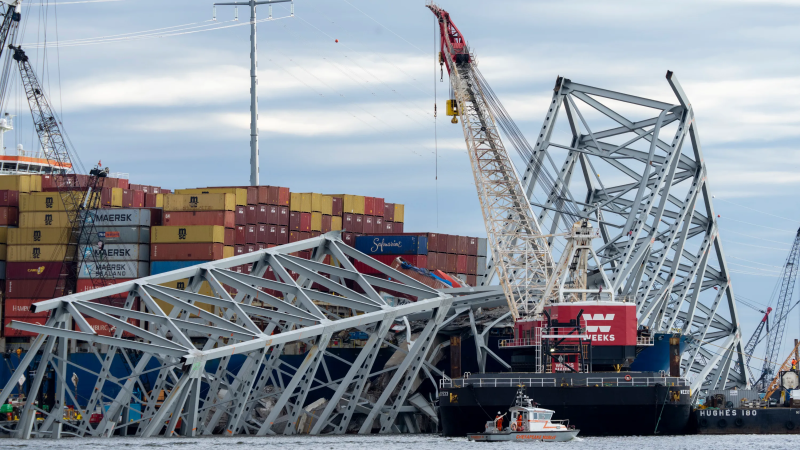Demolition at Baltimore bridge collapse site postponed due to inclement weather
The planned demolition to remove a large steel section from the Francis Scott Key Bridge wreckage in Baltimore has been postponed again due to poor weather conditions and rescheduled to Monday, officials announced.
Demolition crews were scheduled to use small, controlled explosives Sunday to remove a large section of the Key Bridge that has been on top of a container ship since it crashed into one of the bridge’s support columns in late March. Officials have been postponing the operation since Friday because of severe weather, including thunderstorms, in the region.
The demolition has now been tentatively moved to Monday at around 5 p.m. ET, according to the U.S. Army Corps of Engineers for the Baltimore District.
The U.S. Army and the U.S. Army Corps of Engineers said using precision cuts made with small charges to break down the steel span is the "safest and swiftest method." Authorities have estimated that the large section is about 500 feet long and weighs about 600 tons.
The steel span has been on top of the ship since the Dali lost power and collided with one of the bridge's support pylons on March 26, killing six people and shutting down the Port of Baltimore. The FBI opened a criminal probe last month into the collapse, which also halted shipping traffic through one of the nation's most crucial ports.
Once the span is broken down into smaller pieces, officials said crews can begin work on debris removal and re-float the Dali so that it can be removed from the channel.
"We remain focused on restoring the Marine Transportation System, while ensuring the protection of the public and the environment," Capt. David O’Connell, the Key Bridge Response federal on-scene coordinator, said in a statement last week. "By using precision cuts, we reduce risks to our personnel and can safely and efficiently continue clearing the channel for the Port of Baltimore."
'Something's missing here':Body camera footage captures first responders' reactions in wake of Baltimore bridge collapse
Safety zone around Key Bridge wreckage remains in effect
A 2,000-yard safety zone around the bridge wreckage remains in effect and is intended to protect personnel, vessels, and the marine environment, according to the Key Bridge Response Unified Command. Officials said hearing protection is not required outside the 2,000-yard radius as sound levels outside the radius will only last between two to five seconds and "will be no louder than a standard fireworks show."
The precision cuts will look like "multiple puffs of smoke and sound like fireworks," according to the U.S. Army and the Army Corps of Engineers. Officials added that similar methods have been used for the controlled demolition of the Harry W. Nice Memorial Bridge in March 2023 in Charles County, Maryland.
"The small charges, a standard controlled demolition tool, will split the large section of truss resting on the M/V DALI at specific locations to create smaller sections, which allows salvors to use cranes and barges already on scene to clear wreckage and remove the vessel," the Unified Command said.
Officials said the Key Bridge Response Unified Command is working with the Maryland Department of Emergency Management to issue a cellular notification before the controlled demolition. Maryland State Police and other law enforcement agencies will also provide perimeter security around the area and officials have discouraged the public from spectating the demolition.

Port of Baltimore channel to tentatively reopen by end of May
Crews have been working for weeks remove the bridge wreckage to clear out the port. Following the crash, around 1,100 personnel from the Army Corps of Engineers were deployed to the scene to begin the heavy undertaking of removing the wreckage.
Authorities brought highly specialized equipment, including the Chesapeake 1000, the largest floating crane on the Eastern Seaboard. Temporary alternate channels have also been established since the bridge's collapse as part of a "phased approach" to opening the main channel, the Unified Command said.
Last month, the Port of Baltimore said it had "another milestone" after the first container ship arrived at Seagirt Terminal since the collapse. MSC Passion II came through the "35-foot-deep temporary channel," the port said.
The U.S. Army Corps of Engineers anticipates that the Port of Baltimore's permanent 700-foot-wide, 50-foot-deep channel will reopen with normal capacity by the end of May, according to a "tentative" timeline.
Contributing: Cybele Mayes-Osterman and Jonathan Limehouse, USA TODAY; Reuters
Disclaimer: The copyright of this article belongs to the original author. Reposting this article is solely for the purpose of information dissemination and does not constitute any investment advice. If there is any infringement, please contact us immediately. We will make corrections or deletions as necessary. Thank you.







